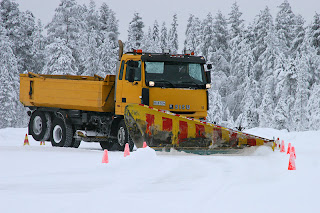Every time we here in Very Northern Florida read the chaos a snowstorm or a little -20C freeze creates we feel so smug. Why can't they handle a little snow without calling national emergency? It's just snow, deal with it! Our airports run just fine all winter.
Well, of course if you get snow only once a year you do not have the fleet of snow removal vehicles we do. And if you usually have temperatures around freezing, you do not have the thick insulation and double- or triple glassed windows on your houses nor the clothes to wear when it gets cold.
Just last week Bornholm got 1,5 meters of snow and that much snow would be a huge problem for us too. About half a meter of snow in a day would be a record breaker for most of the Finland, and more than 25 cm would be exceptional. It's because we are so far north and the air is cold and dry. There just is not much moisture in the air, unlike eg. the Bornholm which is an island surrounded by unfrozen sea.
Oh, the sea freezes here in Very Northern Florida and some people go skiing, skating or ice kiting (a kite pulls the person on skis/skates) or ice sailing there.
Last winter Helsinki, the capital of Finland had problems with a long and snowy winter. It did not snow half a meter a day, but slowly it piled up. There were even calls for recruiting the unemployed to shovel the snow. They have places were they put the snow, but when the snow just kept coming those snow dumps filled up and after that they had nowhere to put it. So the streets were getting narrower and narrower when the snow was plowed to the sides.
The other day I was coming home and saw this pickup truck with a snow plow attached and I managed to shoot it. The city maintenance crews use them to clean bikeways, and they can be used to clean some other areas too. It has it's uses and they can get more plows on the road with these.
 |
| Good for a quick clean-up. |
 |
| Heavy-duty snow moving machine. |
This machine was parked on a street waiting for more snow. As you can see, this is a more serious snow removal tool. It can push hard packed snow away unlike the light truck plow. Machines like this and tractors with a front loader are used to load the snow to trucks or tractor trailers to move the snow to a snow dump if there is not enough space to just plow the snow to the side or if there would be problems with the water when the snow melts in the spring.
Heavy trucks are used to plow the roads and highways and they can grit or salt the road at the same time too. This photo shows some driver testing his skills with the snow plow.
Of course, the farmers can't plow the fields in the winter so they plow the snow. Many farmers work as contractors to clean the smaller roads. The tracktor can be equipped with various tools needed to remove the snow and for gritting. Small roads are not salted.









